Music, memories, and patriotism unite at the Redlands Bowl
"A Star-Spangled Evening of Patriotic Pops” brought thousands to the historic amphitheater Wednesday night
As concerns grow over air pollution, traffic and the unfair cost of sprawling distribution centers, Redlands and other Inland Empire communities are pushing back on new warehouse developments.

REDLANDS, CA – In a region that has steadily transformed from an agricultural to an industrial hub, cities across the Inland Empire are reevaluating their approach to warehouse development.
The reaction follows a massive warehouse expansion across the United States in recent years. The growth of online shopping during the Covid-19 pandemic and record-setting inventory has fueled a warehouse-building frenzy across the country. Amazon alone doubled its warehouse footprint in just the last 24 months. Target announced earlier this year plans to invest $5 billion into logistics. Despite high inflation, demand for warehouse real estate remains strong according to a recent report from CoStar.
Redlands has followed the national trend with a spike in warehouse developments in recent years. More distribution warehouses were built in Redlands in the last six years than in the 11 years prior, according to county parcel data.
There are currently six distribution warehouse projects on the City of Redlands’ Industrial Projects list. If all of these projects go forward, they would add about one million square feet of distribution warehouses in Redlands.
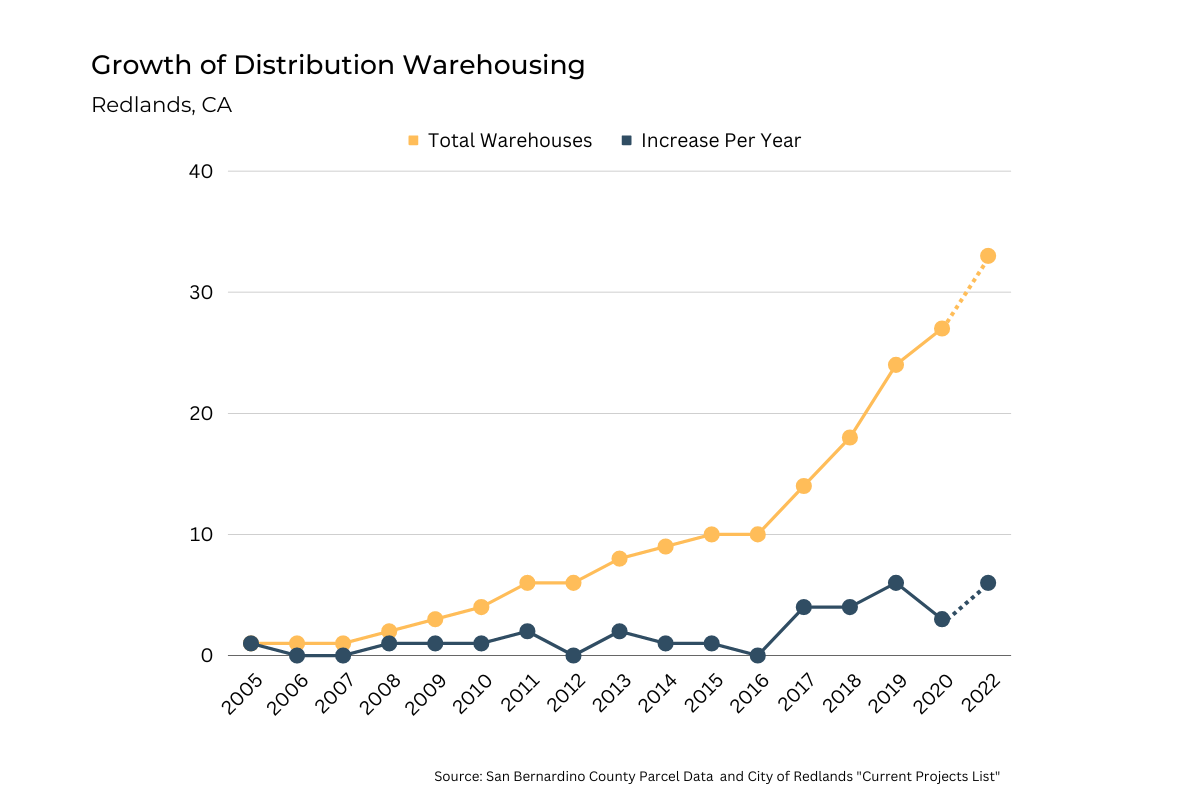
The majority of distribution warehouses in Redlands are found in the North West corner of the City adjacent to an additional 29 warehouses developed by the County Land Use Services.
The map below shows distribution centers pop up from 2005 - 2020 where agricultural land once stood in the northwest corner of Redlands.
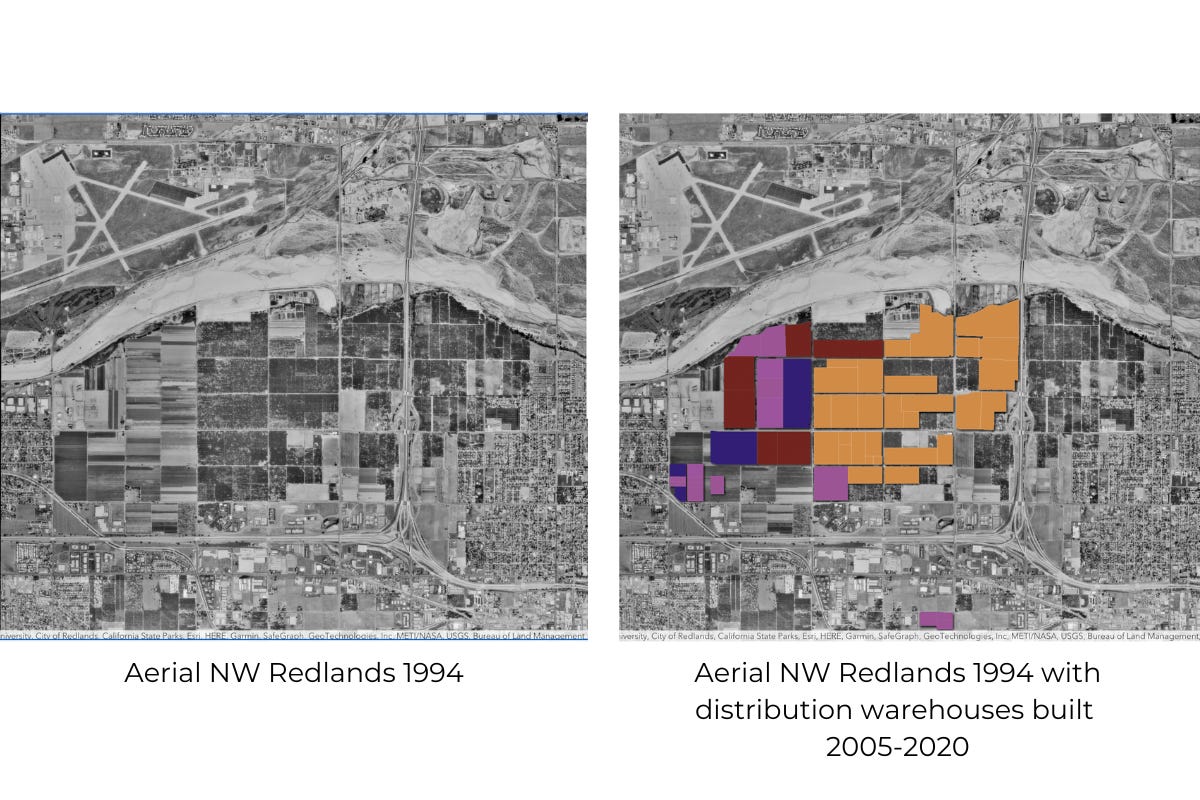
The swift rise of warehouse development in recent years has some local cities looking for ways to slow development while they consider the long-term impacts.
This newsletter will look at what the City of Redlands is proposing to regulate warehouse development and mitigate environmental impacts. Plus take a deeper dive into what’s being done to bring awareness to the environmental and socioeconomic burdens faced by neighborhoods in close proximity to warehouses.
Proposed standards for new warehouse developments will soon go before the City Council. The City of Redlands put a halt on all new warehouse development applications over the summer. The moratorium on new development spans from June 21st thru November 3rd. The purpose: to study and draft a new ordinance regulating where and how warehouse distribution centers can be built in the City.
The moratorium came after increased concern from residents, the Planning Commission and members of the City Council about the impacts warehouses were having on the City, according to the Director of Development Services for the City of Redlands, Brian Desatnik.
“What tipped the table,” Desatnik said, referring to the need for a moratorium at this time, “was we started getting some interest in developing warehouses on properties that were pretty far away from the freeway.” Desatnik was referring to the area in North Redlands by the airport and Redlands Sports Park. The land is zoned for manufacturing, but the type of distribution centers interested in the area would result in increased truck traffic around streets in North Redlands impacting neighborhoods, schools and businesses.
According to the City’s truck route map, deliveries to and from a warehouse in this location would have to travel Lugonia avenue, potentially passing multiple neighborhoods and an elementary school on the way to the freeway. This is illustrated in the map below:
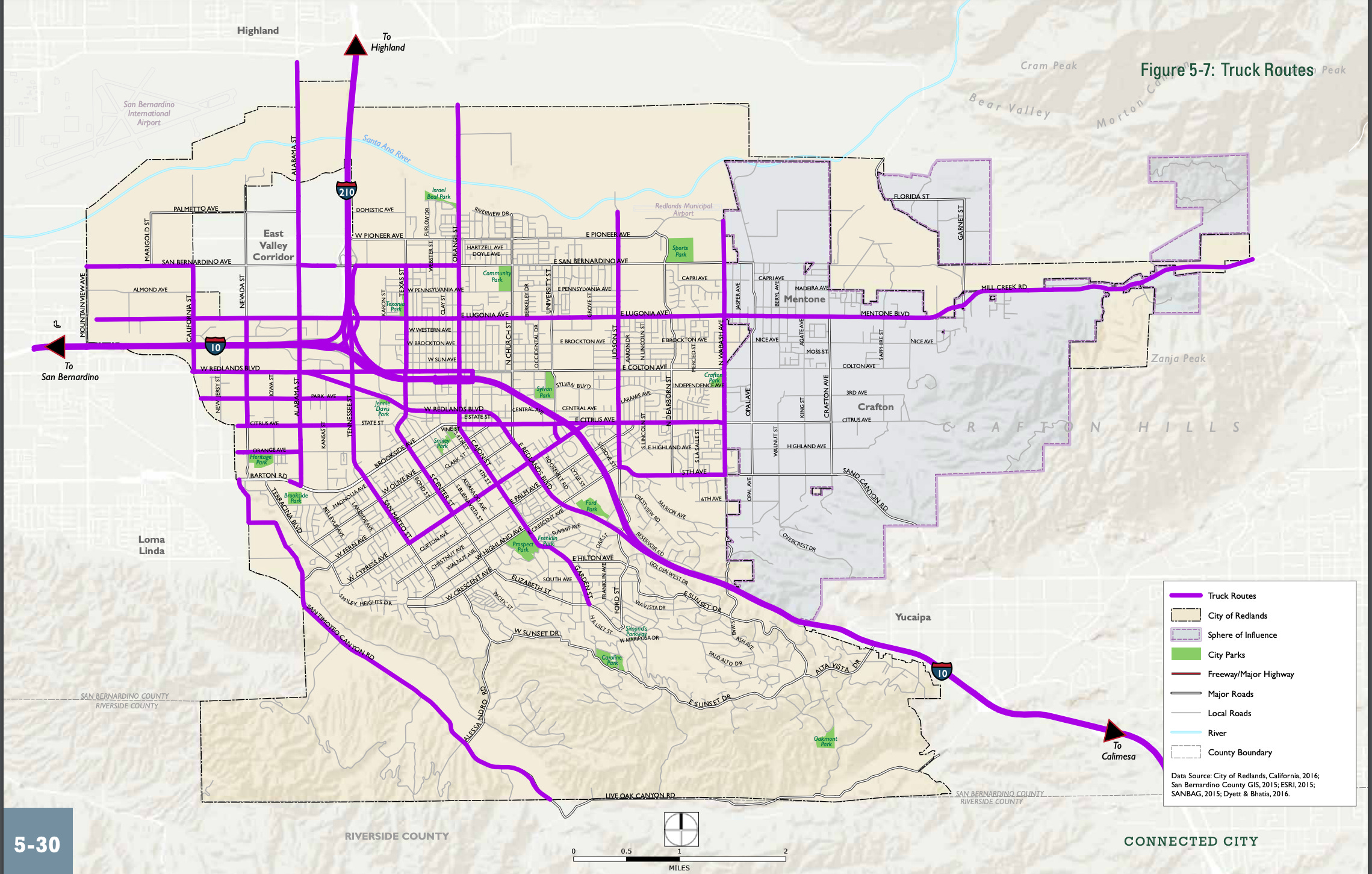
“We realized we need to study this and think about whether that’s actually what we want to do, or whether we want to put some criteria in terms of where these types of warehouses can go,” Desatnik said.
A draft of the proposed ordinance, containing new development standards for warehouses and distribution logistics facilities exceeding 50,000 square feet, was presented to the Planning Commission on July 26.
The proposed ordinance puts limits on warehouse location. It would prevent distribution centers from being any further than one mile from a freeway entrance/exit ramp to I-10 or I-210.
Additionally, no warehouses, distribution centers, or logistics facilities greater than 150,000 square feet - about 2.5 football fields - can be built South of I-10 or East of I-210.
The ordinance also includes new requirements for warehouses to mitigate environmental impacts such as planting and maintaining shade trees, limiting the idling time of trucks, and requiring outdoor operational equipment to be zero emissions. The ordinance would also require solar panels on the roofs of all new warehouses. This last measure goes beyond what the State energy efficiency building codes require but other cities in the region have included a similar requirement.
If the warehouse ordinance passes, the new rules will apply to the warehouse projects currently in the application process.
The City’s moratorium is part of a larger trend in regulating warehouse development in the region. Other cities in the Inland Empire including Fontana, Chino, Colton, Pomona, and Norco have all passed moratoriums on warehouse development in the last year to study the impacts on traffic and the environment. San Bernardino City Council attempted to pass a moratorium in June but was one vote shy.
The final ordinance is expected to go before the Planning Commission for a public hearing in October. After this, the ordinance is expected to be considered by the City Council in November.
Community Forward Redlands will provide updates on the public hearings for this ordinance.
This November voters will decide whether to raise the business license tax for warehouse distribution centers in Redlands.
The current tax rate for distribution centers in the City is about four cents ($.047) per square foot. Measure J would increase the rate to about ten cents ($.107) per square foot.
This change in rate will result in $530,000 in annual revenue for the general fund.
I spoke to Mayor Pro Tem Eddie Tejeda, who prioritized getting the measure on the ballot this November. “I was looking at the landscape and looking at how as a City Council can we slow this thing down,” Tejeda said about the increase in warehouses coming to Redlands. While the City Council doesn’t have the authority to raise taxes on distribution centers, voters can.
The money generated from the tax will go into the City’s general fund. Tejeda wants to see the revenue used to address the environmental impacts that the warehouses have on the City. “Logistically speaking warehouses provide jobs and it's a need,” said Tejeda while also asking, “how can we make it more efficient and more earth-friendly?” Tejeda spoke about the possibility of planting and maintaining the City’s canopy cover or supporting new ideas proposed by the local Climate Policy Committee.
If the new tax increase passes, it will be one of the highest rates for warehouses in the region. However, because demand for warehouse development is so high an increased tax rate is unlikely to impact new warehouse construction, according to city officials.
Mayor Pro Tem Tejeda wrote the argument in favor of the measure. The city clerk did not receive an argument against the measure.
Election day is Tuesday, November 8, 2022.
—
If you need to register to vote in California go here.
Concerns over growth rate, pollution, and social and racial disparities have led to new research and awareness about the impacts of warehouse developments. Here’s a look at some of the motivating factors that led cities around the Inland Empire to adopt moratoriums and rethink warehousing.
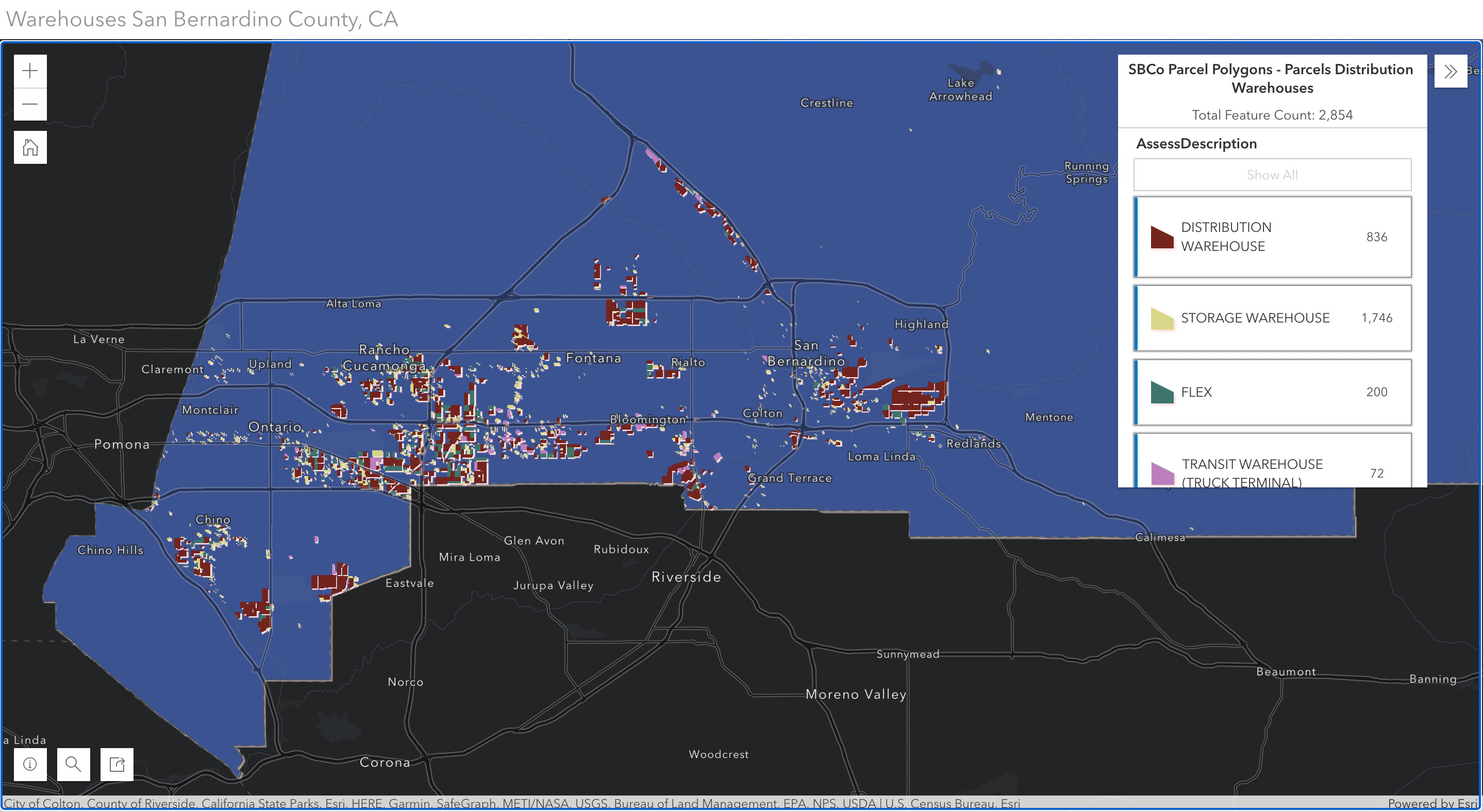
Observable from space, the presence of warehouses in the Inland Empire is unmistakable. Most warehouses in the Inland Empire are located in San Bernardino County. The interactive map above uses parcel data from San Bernardino County to show distribution warehouse clusters throughout the county.
Rapid Growth
Warehousing infrastructure now takes up more than a billion square feet in the Inland Empire, according to research from the Redford Conservancy at Pitzer College. The group mapped the regional warehouse expansion from 1975 to 2021 and found more than 4,300 distribution industry warehouses in the Inland Empire. Due to the recent rapid growth of the logistics industry, both state and local governments are taking aim at the increased traffic and air pollution caused by the goods-moving industry.
Impact on Air Quality
Truck traffic on highways and neighborhood roads around warehouses is a main contributing factor to warehouse industry pollution. According to the California Air Resources Board, trucks are responsible for 70% of the smog-causing pollution and 80% of carcinogenic diesel soot. Trucks make up only 6% of registered vehicles in the state.
Local air quality reflects the high levels of truck traffic in the region. San Bernardino and Riverside counties have the worst ozone quality by county in the nation according to the American Lung Association 2022 report. The counties also ranked in the top 25 for yearly particle pollution. In another report, the CalEnviroScreen shows high levels of diesel particulate matter in neighborhoods around warehouses.
Unfair distribution
The concern over warehouse pollution is compounded by the fact that mega warehouses are often built in disadvantaged neighborhoods. In May 2022, the California EPA released an updated disadvantaged communities designation for the purpose of state climate funding.
This map shows warehouse locations in San Bernardino County and census tracts designated “disadvantaged communities'' in red.
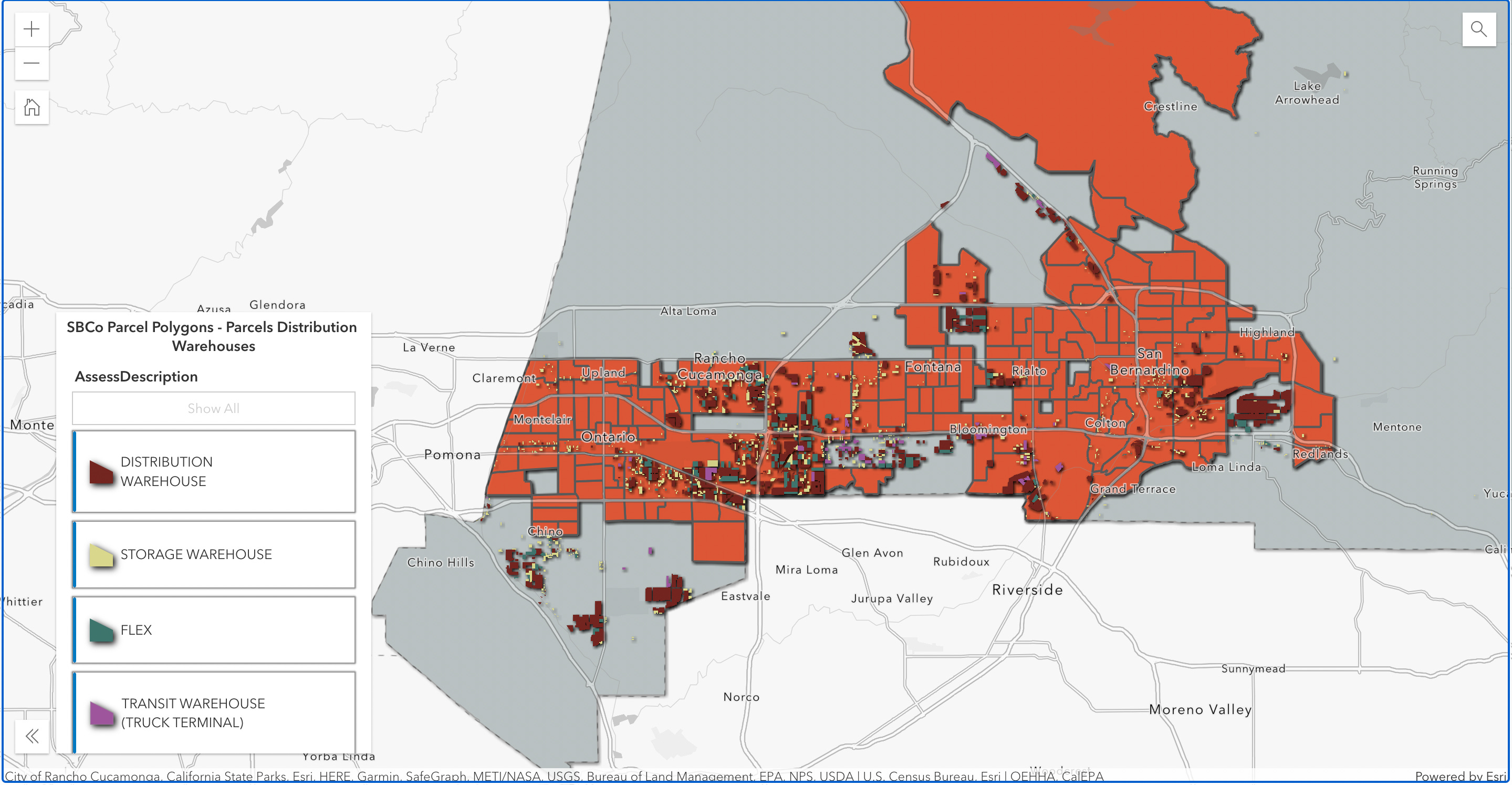
Advocates for social and environmental justice have been sounding the alarm on the inequities of warehouse locations for years.
People’s Collective for Environmental Justice, in a partnership with the University of Redlands, first mapped ways in which social disparities overlap warehouse locations in Southern California. The report found neighborhoods near warehouses see higher rates of asthma and cardiovascular disease. There are also fewer trees and higher overall temperatures around the land used by large distribution centers.
The study also found that the closer a neighborhood is to warehouses the higher the minority population. Within a quarter mile of a warehouse in the Inland Empire, the minority population is 86% while making up a 77% share of the regional population.
Pollution Vulnerability
Data from the CalEnviroScreen 4.0 provides new insight into just how much the neighborhoods in and around warehouse districts are disproportionately impacted by pollution. CalEnviroScreen uses 21 statewide indicators to determine a community's vulnerability to pollution burden with a score from zero to 100.
Red and orange areas have a higher CalEnviroScreen score making those communities more susceptible to environmental impacts brought by warehouses and trucks.
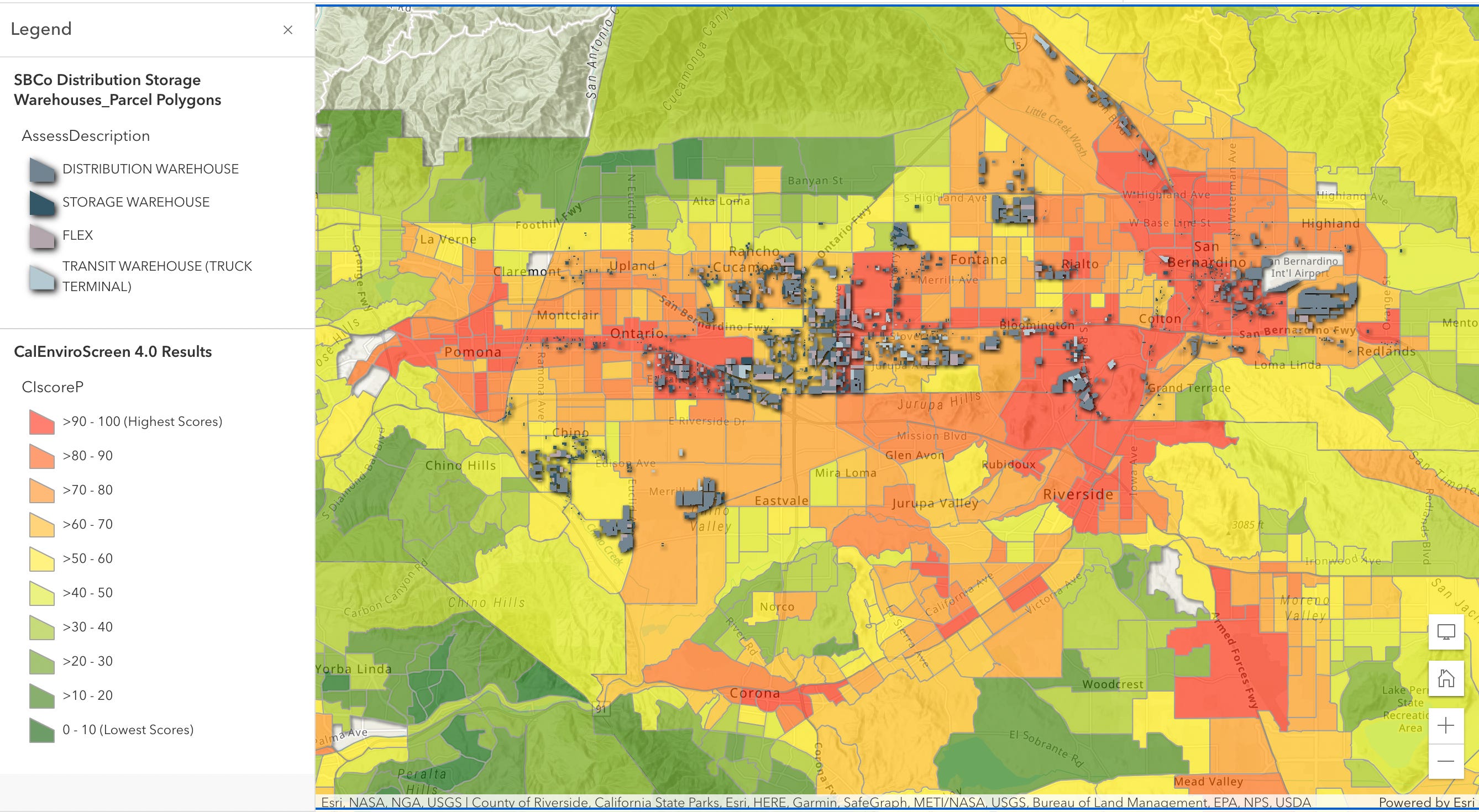
You can explore all of these indicators mapped by the Office of the Environmental Health Hazard Assessment in CalEnviroScreen 4.0
As the warehouse distribution industry continues to look for new land to expand, communities in California’s Inland Empire will grapple with how to balance the need for national logistics without damaging the health and quality of life of its residents.
Here in Redlands, the proposed tax increase could offset the pollution caused by the current warehouse infrastructure whether by funding canopy cover, connectivity through an electric trolley system, or community solar in impacted neighborhoods.
The proposed ordinance to regulate warehouse development provides the City an opportunity to take a more informed approach to future warehouse developments.
The data shows the need to improve health and air quality in the communities closest to warehouse developments but it’s the entire community that will benefit from offsetting the environmental impacts of the logistics industry.
To dig deeper into the maps shared in this newsletter click here
Thank you for reading Community Forward Redlands. This post is public so feel free to share it.
Sign up for our weekly newsletter